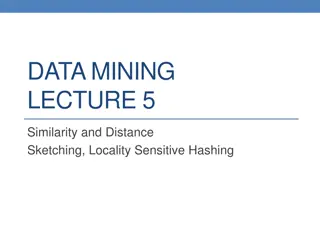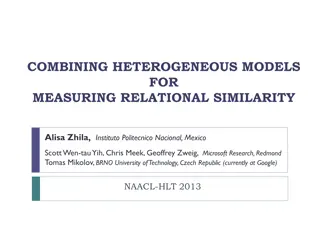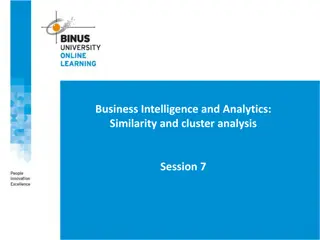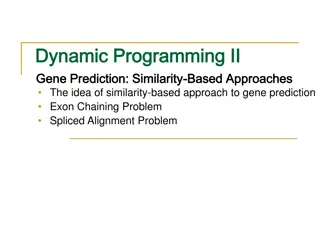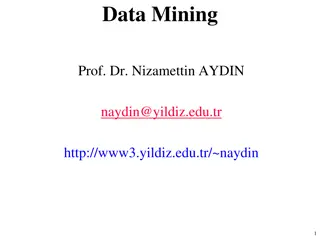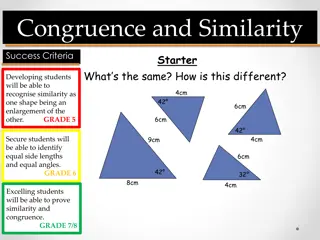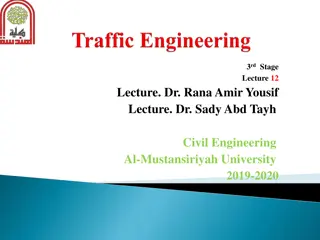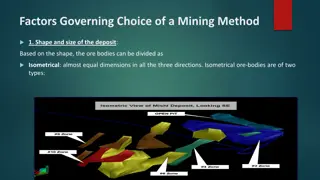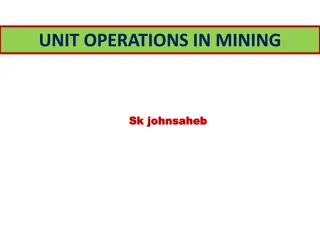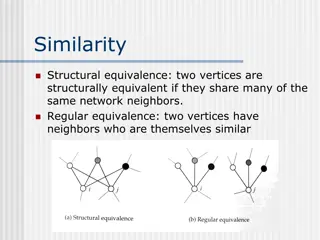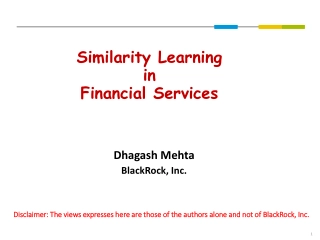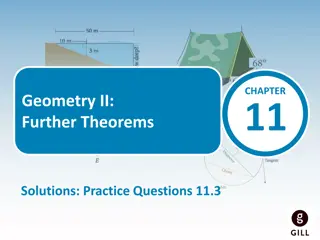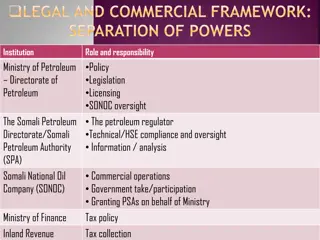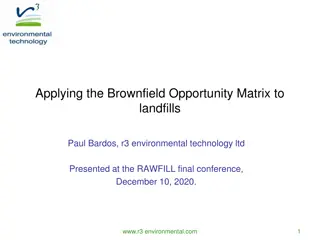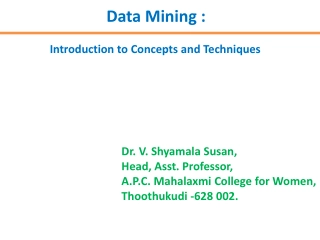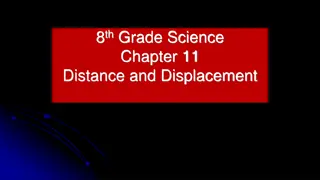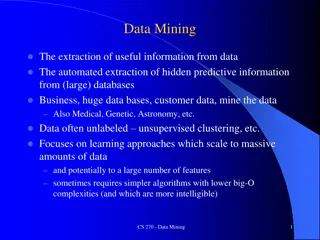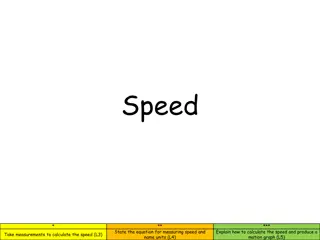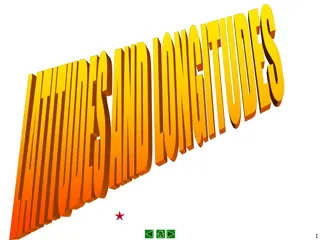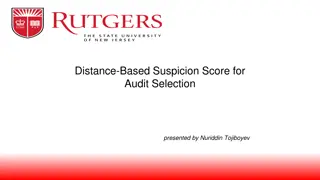Understanding Data Mining Similarity and Distance Concepts
Data mining involves quantifying the closeness of objects through similarity and distance measures. These measures are crucial for various tasks like recommending similar items, grouping customers, and detecting duplicates in web documents. Similarity metrics ensure objects are ranked correctly based on their resemblance, with properties like identity and symmetry. Techniques like Jaccard similarity help compare sets by measuring the intersection over union. By grasping these concepts, one can efficiently analyze and process data for accurate insights and decision-making.
Download Presentation

Please find below an Image/Link to download the presentation.
The content on the website is provided AS IS for your information and personal use only. It may not be sold, licensed, or shared on other websites without obtaining consent from the author. Download presentation by click this link. If you encounter any issues during the download, it is possible that the publisher has removed the file from their server.
E N D
Presentation Transcript
DATA MINING SIMILARITY & DISTANCE Similarity and Distance Recommender Systems
SIMILARITY AND DISTANCE Thanks to: Tan, Steinbach, and Kumar, Introduction to Data Mining Rajaraman and Ullman, Mining Massive Datasets
Similarity and Distance For many different problems we need to quantify how close two objects are. Examples: For an item bought by a customer, find other similar items Group together the customers of a site so that similar customers are shown the same ad. Group together web documents so that you can separate the ones that talk about politics and the ones that talk about sports. Find all the near-duplicate mirrored web documents. Find credit card transactions that are very different from previous transactions. To solve these problems we need a definition of similarity, or distance. The definition depends on the type of data that we have
Similarity Numerical measure of how alike two data objects are. A function that maps pairs of objects to real values Higher when objects are more alike. Often falls in the range [0,1], sometimes in [-1,1] Desirable properties for similarity 1. s(p, q) = 1 (or maximum similarity) only if p = q. (Identity) 2. s(p, q) = s(q, p) for all p and q. (Symmetry)
Similarity between sets Consider the following documents apple releases new ipod apple releases new ipad new apple pie recipe Which ones are more similar? How would you quantify their similarity?
Similarity: Intersection Number of words in common apple releases new ipod apple releases new ipad new apple pie recipe Sim(D,D) = 3, Sim(D,D) = Sim(D,D) =2 What about this document? Vefa releases new book with apple pie recipes Sim(D,D) = Sim(D,D) = 3
7 Jaccard Similarity The Jaccard similarity (Jaccard coefficient) of two sets S1, S2 is the size of their intersection divided by the size of their union. JSim(S1, S2) = |S1 S2| / |S1 S2|. 3 in intersection. 8 in union. Jaccard similarity = 3/8 Extreme behavior: Jsim(X,Y) = 1, iff X = Y Jsim(X,Y) = 0 iff X,Y have no elements in common JSim is symmetric
Jaccard Similarity between sets The distance for the documents apple releases new ipod apple releases new ipad Vefa releases new book with apple pie recipes new apple pie recipe JSim(D,D) = 3/5 JSim(D,D) = JSim(D,D) = 2/6 JSim(D,D) = JSim(D,D) = 3/9
Similarity between vectors Documents (and sets in general) can also be represented as vectors document D1 D2 D3 D4 Apple 10 30 60 0 Microsoft 20 60 30 0 Obama 0 0 0 10 Election 0 0 0 20 How do we measure the similarity of two vectors? We could view them as sets of words. Jaccard Similarity will show that D4 is different form the rest But all pairs of the other three documents are equally similar We want to capture how well the two vectors are aligned
Example document D1 D2 D3 D4 Apple 10 30 60 0 Microsoft 20 60 30 0 Obama 0 0 0 10 Election 0 0 0 20 apple Documents D1, D2 are in the same direction Document D3 is on the same plane as D1, D2 microsoft Document D4 is orthogonal to the rest {Obama, election}
Example document D1 D2 D3 D4 Apple 10 30 60 0 Microsoft 20 60 30 0 Obama 0 0 0 10 Election 0 0 0 20 apple Documents D1, D2 are in the same direction Document D3 is on the same plane as D1, D2 microsoft Document D4 is orthogonal to the rest {Obama, election}
Cosine Similarity Sim(X,Y) = cos(X,Y) The cosine of the angle between X and Y If the vectors are aligned (correlated) angle is zero degrees and cos(X,Y)=1 If the vectors are orthogonal (no common coordinates) angle is 90 degrees and cos(X,Y) = 0 Cosine is commonly used for comparing documents, where we assume that the vectors are normalized by the document length, or words are weighted by tf-idf.
Cosine Similarity - math If d1 and d2 are two vectors, then cos( d1, d2 ) = (d1 d2) / ||d1|| ||d2|| , where indicates vector dot product and || d || is the length of vector d. Example: Note: We only need to consider the non-zero entries of the vectors d1= 3 2 0 5 0 0 0 2 0 0 d2 = 1 0 0 0 0 0 0 1 0 2 d1 d2= 3*1 + 2*0 + 0*0 + 5*0 + 0*0 + 0*0 + 0*0 + 2*1 + 0*0 + 0*2 = 5 ||d1|| = (3*3+2*2+0*0+5*5+0*0+0*0+0*0+2*2+0*0+0*0)0.5 = (42) 0.5 = 6.481 ||d2|| = (1*1+0*0+0*0+0*0+0*0+0*0+0*0+1*1+0*0+2*2)0.5= (6) 0.5 = 2.245 What if we have 0/1 vectors? cos( d1, d2 ) = .3150
Example document D1 D2 D3 D4 Apple 10 30 60 0 Microsoft 20 60 30 0 Obama 0 0 0 10 Election 0 0 0 20 apple Cos(D1,D2) = 1 Cos (D3,D1) = Cos(D3,D2) = 4/5 microsoft Cos(D4,D1) = Cos(D4,D2) = Cos(D4,D3) = 0 {Obama, election}
Correlation Coefficient The correlation coefficient measures correlation between two random variables. If we have observations (vectors) ? = (?1, ,??) and ? = (?1, ,??) is defined as ?(?? ??)(?? ??) ??? ?? ?????????(?,?) = 2 2 ??? ?? This is essentially the cosine similarity between the normalized vectors (where from each entry we remove the mean value of the vector. The correlation coefficient takes values in [-1,1] -1 negative correlation, +1 positive correlation, 0 no correlation. Most statistical packages also compute a p-value that measures the statistical importance of the correlation Lower value higher statistical importance
Correlation Coefficient Normalized vectors document D1 D2 D3 D4 Apple -5 -15 +15 0 Microsoft +5 +15 -15 0 Obama 0 0 0 -5 Election 0 0 0 +5 ?(?? ??)(?? ??) ??? ?? ?????????(?,?) = 2 2 ??? ?? CorrCoeff(D1,D2) = 1 CorrCoeff(D1,D3) = CorrCoeff(D2,D3) = -1 CorrCoeff(D1,D4) = CorrCoeff(D2,D4) = CorrCoeff(D3,D4) = 0
Distance Numerical measure of how different two data objects are A function that maps pairs of objects to real values Lower when objects are more alike Higher when two objects are different Minimum distance is 0, when comparing an object with itself. Upper limit varies
Distance Metric A distance function d is a distance metric if it is a function from pairs of objects to real numbers such that: ? ?,? 0. (non-negativity) ?(?,?) = 0 iff ? = ?. (identity) ?(?,?) = ?(?,?). (symmetry) ? ?,? ?(?,?) + ?(?,?) (triangle inequality ). 1. 2. 3. 4.
Triangle Inequality Triangle inequality guarantees that the distance function is well- behaved. The direct connection is the shortest distance It is useful also for proving useful properties about the data.
Example We have a set of objects ? = {?1, ,??} of a universe ? (e.g., ? = ?), and a distance function ? that is a metric. We want to find the object ? ? that minimizes the sum of distances from ?. For some distance metrics this is easy, for some it is an NP-hard problem. It is easy to find the object ? ? that minimizes the distances from all the points in ?. But how good is this? We can prove that ?(?,? ) 2 ? ?,? ? ? ? ? We are a factor 2 away from the best solution.
Distances for real vectors Vectors ? = ?1, ,?? and ? = (?1, ,??) Lp norms are known to be distance metrics ??-norms or Minkowskidistance: 1? ?+ + ?? ?? ? ???,? = ?1 ?1 ??-norm: Euclidean distance: ?1 ?12+ + ?? ??2 ?2?,? = ??-norm: Manhattan distance: ?1?,? = ?1 ?1+ + |?? ??| ? -norm: ? ?,? = max ?1 ?1, ,|?? ??| The limit of ?? as p goes to infinity.
22 Example of Distances y = (9,8) ?2-norm: ????(?,?) = 42+ 32= 5 5 3 ?1-norm: ????(?,?) = 4 + 3 = 7 4 x = (5,5) ? -norm: ????(?,?) = max 3,4 = 4
Example r ? = (?1, ,??) Green: All points y at distance ?1(?,?) = ? from point ? Blue: All points y at distance ?2(?,?) = ? from point ? Red: All points y at distance ? (?,?) = ? from point ?
?? distances for sets We can apply all the Lp distances to the cases of sets of attributes, with or without counts, if we represent the sets as vectors E.g., a transaction is a 0/1 vector E.g., a document is a vector of counts.
Similarities into distances Jaccard distance: ?????(?,?) = 1 ????(?,?) Jaccard Distance is a metric Cosine distance: ????(?,?) = 1 cos(?,?) Cosine distance is a metric
27 Hamming Distance Hamming distance is the number of positions in which bit-vectors differ. Example: p1 = 10101 p2 = 10011. ?(?1,?2) = 2 because the bit-vectors differ in the 3rd and 4th positions. The L1 norm for the binary vectors Hamming distance between two vectors of categorical attributes is the number of positions in which they differ. Example: x = (married, low income, cheat) y = (single, low income, not cheat) ?(?,?) = 2
28 Why Hamming Distance Is a Distance Metric d(x,x) = 0 since no positions differ. d(x,y) = d(y,x) by symmetry of different from. d(x,y) > 0 since strings cannot differ in a negative number of positions. Triangle inequality: changing x to z and then to y is one way to change x to y. For binary vectors if follows from the fact that L1 norm is a metric
Distance between strings How do we define similarity between strings? weird intelligent unintelligent Athena Athina wierd Important for recognizing and correcting typing errors and analyzing DNA sequences.
30 Edit Distance for strings The edit distance of two strings is the number of inserts and deletes of characters needed to turn one into the other. Example: x = abcde ; y = bcduve. Turn x into y by deleting a, then inserting u and v after d. Edit distance = 3. Minimum number of operations can be computed using dynamic programming Common distance measure for comparing DNA sequences
31 Why Edit Distance Is a Distance Metric d(x,x) = 0 because 0 edits suffice. d(x,y) = d(y,x) because insert/delete are inverses of each other. d(x,y) > 0: no notion of negative edits. Triangle inequality: changing x to z and then to y is one way to change x to y. The minimum is no more than that
32 Variant Edit Distances Allow insert, delete, and mutate. Change one character into another. Minimum number of inserts, deletes, and mutates also forms a distance measure. Same for any set of operations on strings. Example: substring reversal or block transposition OK for DNA sequences Example: character transposition is used for spelling
Distance between sets of points How do we measure the distance between the two sets?
Distance between sets of points How do we measure the distance between the two sets? Minimum distance over all pairs
Distance between sets of points How do we measure the distance between the two sets? Minimum distance over all pairs Maximum distance over all pairs
Distance between sets of points How do we measure the distance between the two sets? Minimum distance over all pairs Maximum distance over all pairs Average distance over all pairs
Distance between sets of points How do we measure the distance between the two sets? Minimum distance over all pairs Maximum distance over all pairs Average distance over all pairs Distance between averages
Distance between sets of points How do we measure the distance between the two sets? Minimum distance over all pairs Maximum distance over all pairs Average distance over all pairs Distance between averages Hausdorff distance: For each red point ? compute the distance to the closest Blue point: ? ?,???? = min ? ?????(?,?)
Distance between sets of points How do we measure the distance between the two sets? Minimum distance over all pairs Maximum distance over all pairs Average distance over all pairs Distance between averages Hausdorff distance: For each red point ? compute the distance to the closest Blue point: ? ?,???? = min ? ?????(?,?) Find the maximum: this is the distance from Red to Blue: ? ???,???? = max ? ??? ?(?,????)
Distance between sets of points How do we measure the distance between the two sets? Minimum distance over all pairs Maximum distance over all pairs Average distance over all pairs Distance between averages Hausdorff distance: For each red point ? compute the distance to the closest Blue point: ? ?,???? = min ? ?????(?,?) Find the maximum: this is the distance from Red to Blue: ? ???,???? = max Compute the ? ????,??? ? ??? ?(?,????)
Distance between sets of points How do we measure the distance between the two sets? Minimum distance over all pairs Maximum distance over all pairs Average distance over all pairs Distance between averages Hausdorff distance: For each red point ? compute the distance to the closest Blue point: ? ?,???? = min ? ?????(?,?) Find the maximum: this is the distance from Red to Blue: ? ???,???? = max Compute the ? ????,??? Take the maximum of the two ?????,???? = max max ? ??? ?(?,????) ? ??? min ? ?????(?,?), max ? ??? min ? ?????(?,?)
Distances between distributions Some times data can be represented as a distribution (e.g., a document is a distribution over the words) document D1 D2 D3 Apple 0.35 0.4 0.05 Microsoft 0.5 0.4 0.05 Obama 0.1 0.1 0.6 Election 0.05 0.1 0.3 How do we measure distance between distributions?
Variational distance Variational distance: The ?1 distance between the distribution vectors document Apple Microsoft Obama Election Dist(D1,D2) = 0.05+0.1+0.05 = 0.2 0.35 0.5 0.1 0.05 D1 Dist(D2,D3) = 0.35+0.35+0.5+ 0.2 = 1.4 0.4 0.4 0.1 0.1 D2 0.05 0.05 0.6 0.3 D3 Dist(D1,D3) = 0.3+0.45+0.5+ 0.25 = 1.5 0.7 0.6 0.5 0.4 0.3 0.2 0.1 0 Apple Microsoft Obama Election D1 D2 D3
document Apple Microsoft Obama Election D1 0.35 0.5 0.1 0.05 Information theoretic distances D2 0.4 0.4 0.1 0.1 D3 0.05 0.05 0.6 0.3 KL-divergence (Kullback-Leibler) for distributions P,Q ? ? log?(?) ???? ? = ?(?) ? KL-divergence is asymmetric. We can make it symmetric by taking the average of both sides 1 2 JS-divergence (Jensen-Shannon) ?? ?,? = ? =1 2(? + ?) ???? ? + ???? ? 1 2???? ? + 1 2???? ? Average distribution
Ranking distances The input in this case is two rankings/orderings of the same ? items. For example: ?1= ?,?,?,? ?2= ?,?,?,? How do we define distance in this case? Kendal s tau: Number of pairs of items that are in different order: ?,? , ?,? , ?,? ,(?,?) Defines a metric. Maximum: ? ? 1 2 Spearman rank distance: ?1distance between the ranks ?? ?1,?2 = 1 4 + 2 1 + 3 3 + 4 2 = 6 = 4 when rankings are reversed. x y 2 1 z 3 3 w 4 2 ?1 1 ?2 4
Why is similarity important? We saw many definitions of similarity and distance How do we make use of similarity in practice? What issues do we have to deal with?
APPLICATIONS OF SIMILARITY: RECOMMENDATION SYSTEMS
An important problem Recommendation systems When a user buys an item (initially books) we want to recommend other items that the user may like When a user rates a movie, we want to recommend movies that the user may like When a user likes a song, we want to recommend other songs that they may like A big success of data mining Exploits the long tail How Into Thin Air made Touching the Void popular
The Long Tail Source: Chris Anderson (2004)
Utility (Preference) Matrix Harry Potter 1 4 5 Harry Potter 2 Harry Potter 3 Twilight Star Wars 1 1 Star Wars 2 Star Wars 3 A B C D 5 5 4 2 4 5 3 3 Rows: Users Columns: Movies (in general Items) Values: The rating of the user for the movie How can we fill the empty entries of the matrix?
Recommendation Systems Content-based: Represent the items into a feature space and recommend items to customer C similar to previous items rated highly by C Movie recommendations: recommend movies with same actor(s), director, genre, Websites, blogs, news: recommend other sites with similar content



